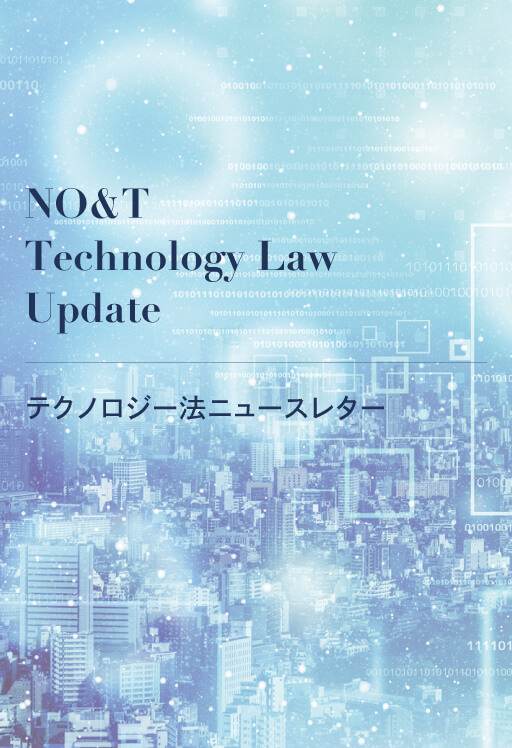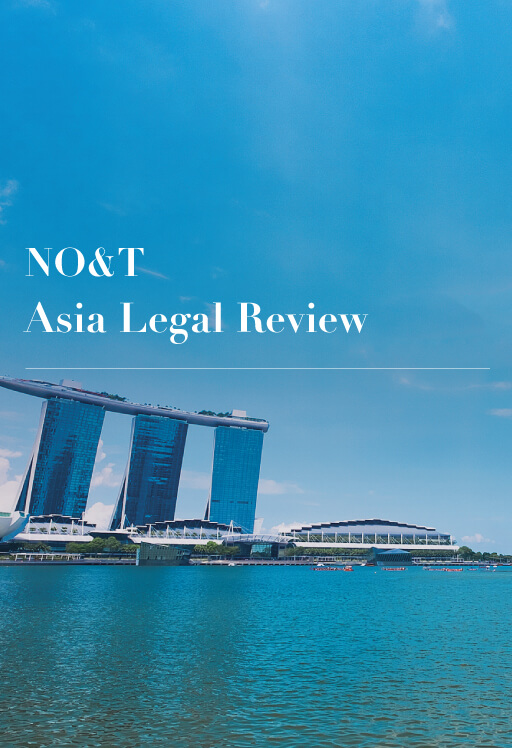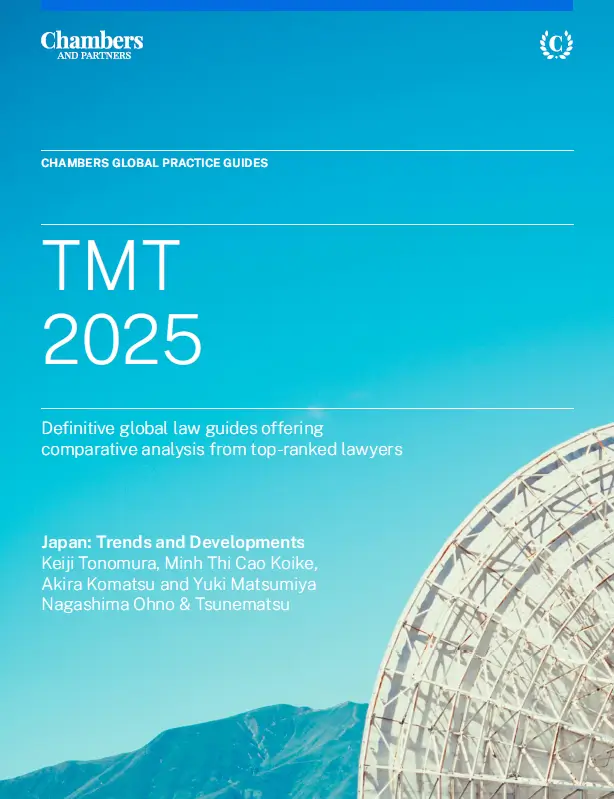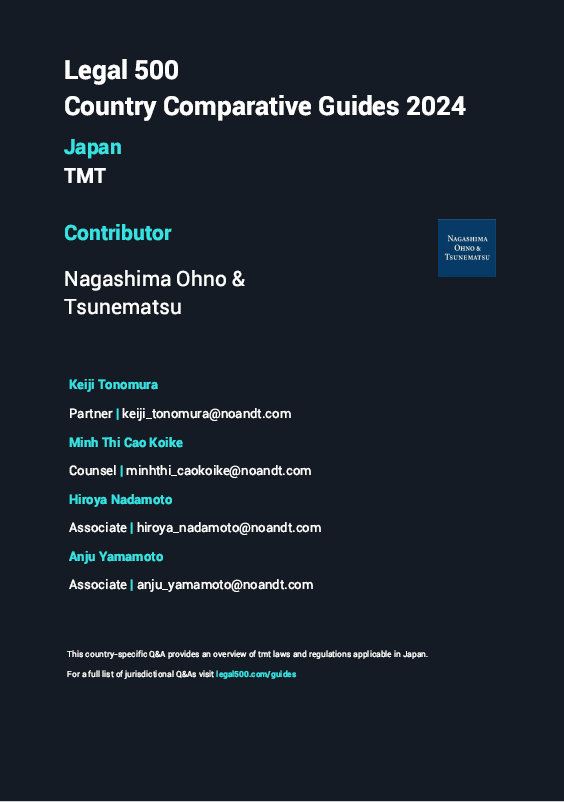
NO&T Technology Law Update
This article is also available in Japanese.
On March 29, 2024, the Ministry of Land, Infrastructure, Transport and Tourism (“MLIT”) established a new regime allowing for the provision of paid transportation services by local private vehicles and non-professional drivers under the management of taxi business operators (“Private Vehicle Utilization Business”), and issued a guideline (“Guideline”) regarding permits for the provision of such services under the Road Transport Act※1. The Guideline stemmed from the “Interim Summary of Digital Administrative and Fiscal Reform”※2 decided in December 2023, which established a regime (based on Article 78, Item 3 of the Road Transport Act) for taxi business operators to utilize local private vehicles and drivers to supply transportation services in areas in which the number of taxis is insufficient. The Guideline also took into account public comments gathered from February to March 2024. Going forward, the permits allowing for the provision of paid transportation services by local private vehicles and non-professional drivers will be issued in accordance with the Guideline when a shortage of taxis is recognized in certain areas, times or periods.
The Private Vehicle Utilization Business regime has been seen as partially lifting ride-hailing restrictions in Japan, not only increasing convenience for local residents and tourists alike, but also expanding and creating business opportunities for, among others, taxi business operators and taxi hailing application providers, as well as creating income-generating opportunities for citizens.
In this newsletter, we will introduce an overview of the Private Vehicle Utilization Business regime and the requirements and conditions of the permit under the Guideline.
The Road Transport Act generally prohibits paid transportation by private vehicles (i.e., vehicles which are not used for business purposes), with exceptions granted in limited circumstances: (1) when urgently needed due to a disaster, (2) when municipalities or non-profit organizations registered by the MLIT, provide transportation for local residents, tourists, etc., and (3) when it is necessary to ensure public welfare, and permitted by the MLIT, to conduct transportation within specified regions or periods (Article 78 of the Road Transport Act).
The Guideline permits paid transportation by private vehicles under the aforementioned category “(3)” in cases of insufficient taxis in certain regions, times or periods. It is important to note that the new regime does not generally endorse ride-hailing in Japan, since the Private Vehicle Utilization Business presupposes that taxi business operators (as opposed to individuals) conduct the relevant transportation business and are responsible for managing and supervising non-professional drivers, and because it is limited to specific regions and times and a certain number of vehicles. Discussions regarding the legal framework generally allowing ride-hailing for business entities other than taxi business operators are slated to be held through June 2024, as outlined in the “Interim Summary of Digital Administrative and Fiscal Reform.”
In order to conduct the Private Vehicle Utilization Business, corporate taxi business operators are required to apply for permission to the competent transport bureau authority. Upon receiving the application, it will be examined to determine whether it meets the following requirements; if it is found to meet these requirements, permission will be granted.
| Requirements | Overview | |
|---|---|---|
| (1) | Target areas, periods, time slots, number of shortage of vehicles | Areas, periods, and time slots where taxis are in short supply, along with the number of shortage of vehicles designated by the MLIT. |
| (2) | Qualification | Holding a permit for general passenger car transportation business under the Road Transport Act (i.e., a taxi business operator). |
| (3) | Management and operational systems |
|
| (4) | Financial capacity for damages | For the Private Vehicle Utilization Business, it is required to have insurance or mutual aid coverage with liability limits of at least JPY 80 million for bodily injury and JPY 2 million for property damage. Alternatively, there should be a specific plan in place to obtain such insurance or coverage before commencing operational activities. |
Regarding (1) above, on March 13, 2024, the shortage of vehicles per day and time slot was disclosed for 4 regions: Tokyo’s 23 wards, Musashino City and Mitaka City; Keihin area (Yokohama City, Kawasaki City Yokosuka City, etc.); Nagoya area (Nagoya City, Seto City, Nisshin City, etc.); and Kyoto area (Kyoto City, Uji City, Nagaokakyo City, etc.) ※3. Additionally, it is anticipated that vehicle shortage data will be disclosed for the regions of Sapporo, Sendai, Saitama, Chiba, Osaka, Kobe, Hiroshima, and Fukuoka by April 2024, expanding the areas in which the Private Vehicle Utilization Business regime can be implemented.
Regarding (3) above, the requirement to “monitor the working hours in other occupations” for the Private Vehicle Drivers implies that they do not need to engage exclusively in transportation services using private vehicles. As detailed later, however, the permit conditions for the Private Vehicle Utilization Business include measures for preventing overwork, among other things, as part of operational management by taxi business operators. Therefore, taxi business operators are expected to manage the labor of the Private Vehicle Drivers appropriately, taking into account their working hours in other occupations. It is also notable that the Private Vehicle Drivers are supposed to become “employees” (as opposed to independent contractors) of taxi business operators.
For the permission of the Private Vehicle Utilization Business, the following conditions are imposed, and the permission period is set to 2 years. Violation of these conditions inhering in the granted permission may result in administrative penalties such as suspension of business or revocation of permission.
| Conditions | Overview | |
|---|---|---|
| (1) | Private vehicles to be used |
|
| (2) | Private Vehicle Drivers |
|
| (3) | Operations management and vehicle maintenance management | To conduct operations management and vehicle maintenance management based on related guidelines. |
| (4) | Transportation mode and manner |
|
| (5) | Reporting of operational status | To keep records of the operational status of available private vehicles and to report these records upon request from the transport bureau. |
These conditions not only require taxi business operators to apply the same management and supervision to the Private Vehicle Drivers as they do to their employed taxi drivers, but also necessitate additional management and measures due to the use of private vehicles. Taxi business operators are expected to design systems, including the establishment of organizational systems and development/introduction of relevant IT systems, to ensure adequate compliance with the permit conditions.
Furthermore, as per condition (4) above, the use of taxi hailing applications is anticipated in the Private Vehicle Utilization Business. Applicants for permission are required to specify the names of the applications used for hailing and fare calculation in their application forms.
While the Private Vehicle Utilization Business was established under Article 78, Item 3 of the Road Transport Act, measures are being implemented and considered to improve the system of private paid passenger transportation under Article 78, Item 2 (“Private Paid Passenger Transportation”). Specifically, by the end of 2023, the following measures were taken or considered:
Additionally, measures such as the introduction of dynamic pricing and the establishment of cooperative mechanisms with taxis have been discussed.
It is expected that the use of private vehicles for paid passenger transportation will increase under both the Private Vehicle Utilization Business and the system of Private Paid Passenger Transportation. While there has already been a great deal of discussion regarding the legalization of ride-hailing businesses in Japan compared to other countries, there will be further consideration of the general legal framework for non-taxi ride-hailing business operators through June 2024. Therefore, it is essential to continue monitoring the progress and direction of, and legislative developments issuing from, these discussions.
*1
https://www.mlit.go.jp/report/press/content/001734883.pdf (written in Japanese)
*2
https://www.cas.go.jp/jp/seisaku/digital_gyozaikaikaku/pdf/chukan_honbun.pdf (written in Japanese)
*3
https://www.mlit.go.jp/report/press/content/001730147.pdf (written in Japanese)
This newsletter is given as general information for reference purposes only and therefore does not constitute our firm’s legal advice. Any opinion stated in this newsletter is a personal view of the author(s) and not our firm’s official view. For any specific matter or legal issue, please do not rely on this newsletter but make sure to consult a legal adviser. We would be delighted to answer your questions, if any.


Hoai Truong


(August 2025)
Keiji Tonomura, Yoshiteru Matsuzaki (Co-author)


(July 2025)
Ryo Okubo, Yu Takahashi, Uchu Takehara, Naoto Obara (Co-author)


(June 2025)
Keiji Tonomura, Yukiko Konno, Minh Thi Cao Koike, Yoshiteru Matsuzaki (Co-author)


(February 2025)
Keiji Tonomura, Minh Thi Cao Koike, Akira Komatsu, Yuki Matsumiya (Co-author)


(May 2024)
Masaki Mizukoshi, Akira Komatsu (Co-author)


(April 2024)
Junichi Ikeda, Takayuki Fujii, Mai Nishigori (Co-author)


Keiji Tonomura, Masaki Mizukoshi, Akira Komatsu (Co-author)


(June 2025)
Keiji Tonomura, Yukiko Konno, Minh Thi Cao Koike, Yoshiteru Matsuzaki (Co-author)


Yuan Yao Lee


(August 2024)
Keiji Tonomura, Minh Thi Cao Koike, Hiroya Nadamoto, Anju Yamamoto (Co-author)


Keiji Tonomura, Akira Komatsu, Chie Komiya, Simon Clemens Wegmann (Gleiss Lutz) (Co-author)